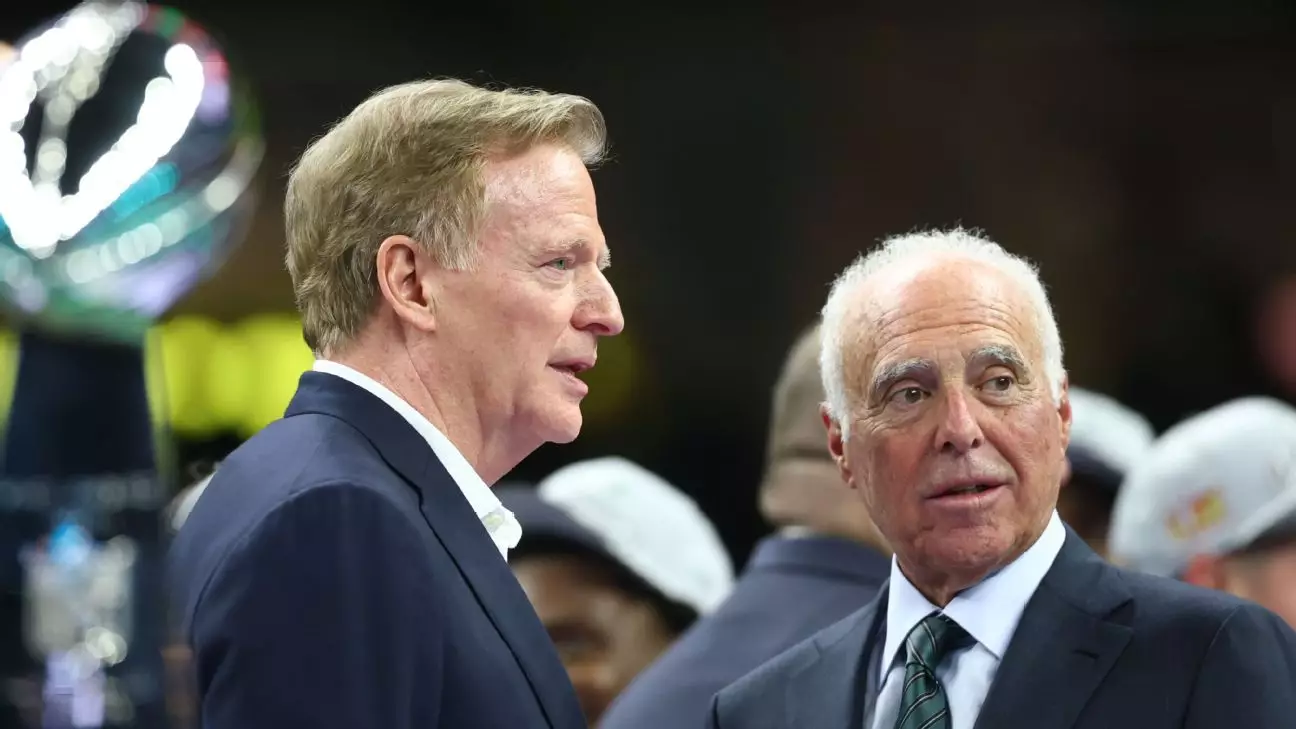In a world where the NFL reigns as a colossal titan of American sports, debates can turn ferocious, often reflecting deeper controversies within the game itself. The latest battleground? A little-known play dubbed the “tush push,” which faced scrutiny during a recent meeting in Eagan, Minnesota, that pitted the Philadelphia Eagles against a collective of skeptical NFL owners and executives. When put under such a glaring spotlight, the tensions surrounding this contest reveal more than just divisions on the football field; they illuminate a league grappling with its identity, its problems, and its power dynamics.
As the discussions unfolded in what is known as a “general session,” tensions erupted as Eagles owner Jeffrey Lurie passionately defended the play, likening its controversial nature to a high-stakes gamble on the football field. He brought forth an emotional argument that had the potential to rally support, unveiling his apprehensions regarding a proposed ban. Stating that the ban would ultimately be a liability for quarterbacks and their safety, Lurie launched into an hour-long speech that was not just persuasive but laced with raw emotion, clearly underscoring how much was at stake for his franchise.
Unexpected Analogies and Defensive Postures
Strikingly, Lurie’s comparison of the tush push to a “wet dream for a teenage boy” raised eyebrows, particularly among the women present in the room—a faux pas that elicited chastisement from NFL executive Troy Vincent. This awkward moment epitomized the old-fashioned attitudes still prevalent in professional sports, showcasing a disconnect that persists within the upper echelons of the NFL’s hierarchy. The juxtaposition of high-level discussions about player safety with such juvenile language not only highlighted Lurie’s desperation but also underscored a significant cultural gap within the league’s leadership.
Lurie may have intended to invoke passion with his metaphoric exuberance, but instead, he bordered on farce—with the likes of former Eagles star Jason Kelce chiming in, unabashedly singing praises of the play’s effectiveness by joking about his wish to run 60 tush pushes a game if given the chance. In a league that ostensibly prides itself on serious discussions regarding player health and safety, the lightheartedness with which the debate shifted could easily dilute the gravity of the issue at hand.
The Anatomy of Division
The ensuing deliberation between owners, including Jerry Jones of the Dallas Cowboys and Terry Pegula of the Buffalo Bills who champion opposing views on the play, illustrated the fragmented nature of the NFL stakeholders. On one hand, you have owners who see the efficacy and appeal of the tush push—essentially a strategic advantage that can make or break games. On the other hand, critics worried about the risks involved, citing player safety as a paramount concern. The blunt reality is this: player safety has often been a convenient buzzword, selectively invoked when it aligns with owners’ interests.
The vote that fell short of bans—22-10 against—the unwillingness of owners to unite on the issue reveals an increasingly complex narrative. Many owners may support the idea of banning the play but are cognizant of their own teams’ performative strategies—appropriating the very moves that are controversial for their own gain. Thus, for the NFL, this debate encapsulates more than just a trivial play—it’s reflective of the inherent contradictions within a league attempting to uphold integrity while still navigating the merciless waters of competition and profitability.
Leadership and Accountability in the NFL
The entire ordeal casts doubt on the effectiveness of NFL leadership. Roger Goodell’s follow-through on player safety remains questionable when complex issues such as the tush push expose the broader inadequacies within the league’s decision-making framework. In embracing a committee-driven approach to such matters, the NFL has tantalizingly opened Pandora’s box; the debate has morphed into a microcosm of the greater struggle for authentic reform in an institution that has long resisted change.
Ultimately, this quintessential tussle between the Eagles and other key stakeholders has thrust into the limelight the uncomfortable truths about the NFL. It is a league caught in the crosshairs between maintaining the thrill of sport and keeping its players secure. While the tussle over the tush push may seem trivial at first glance, it transforms into a compelling narrative about the nature of sports, power, and the delicate balance that governs them. How the NFL navigates these turbulent waters will not only affect its immediate future but will shape the very integrity of the sport for generations to come.


Leave a Reply